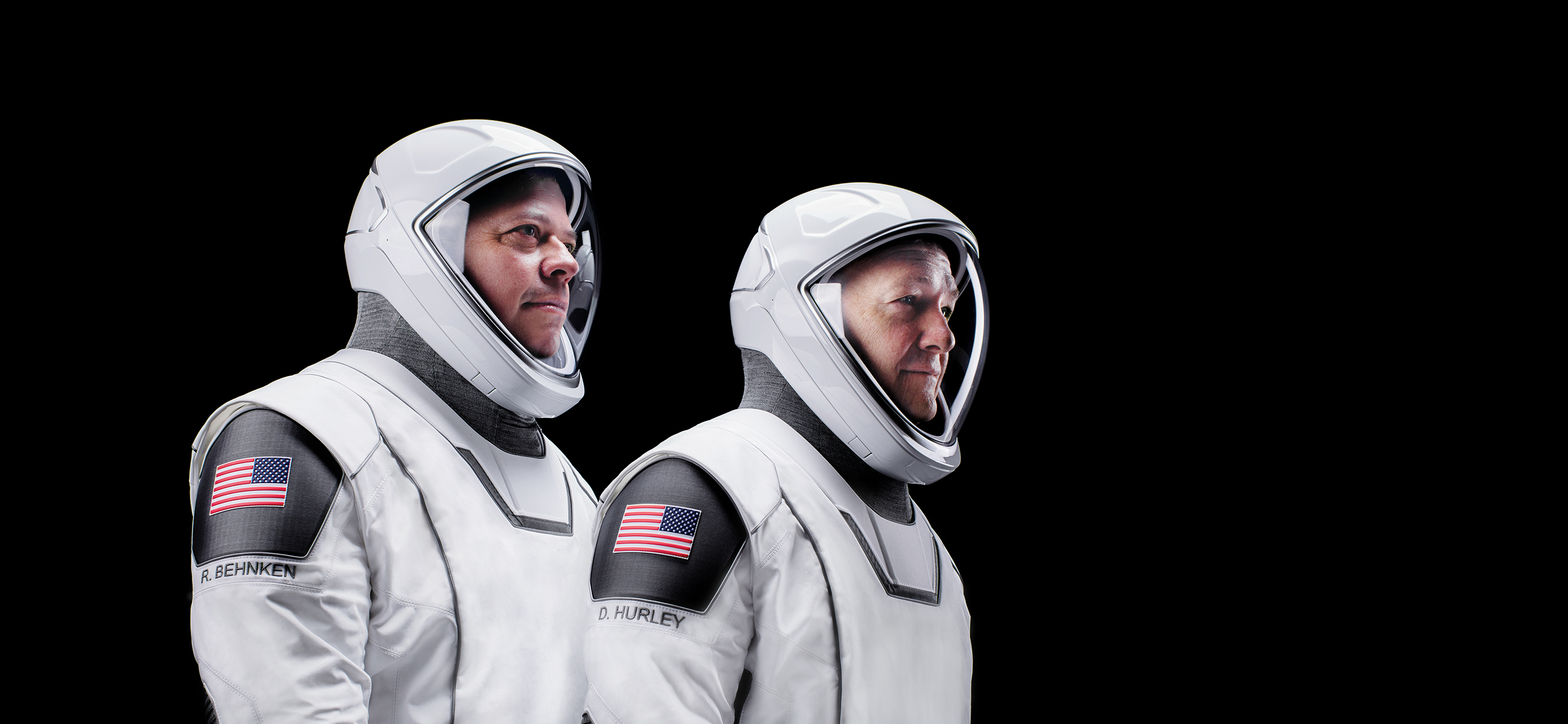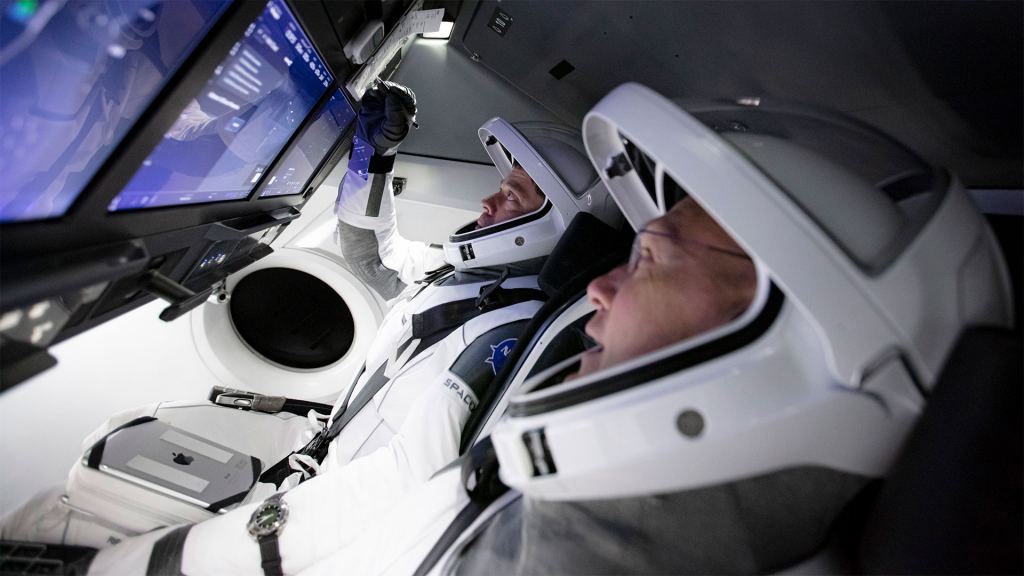Tomorrow, Wednesday, May 27th, NASA and SpaceX will make history as they conduct the long-awaited second demonstration of the Crew Dragon spacecraft. Dubbed Demo-2, this mission will not only see SpaceX’s crewed spacecraft sent to space for the first time with astronauts aboard, it will also be the first time since 2011 (and the retiring of the Space Shuttle) that astronauts are launched from US soil.
NASA astronauts Bob Behnken and Doug Hurley will fly aboard the Crew Dragon spacecraft as it takes off from Launch Complex 39A at NASA’s Kennedy Space Center, Florida. This will be the final test of the human spaceflight system SpaceX developed as part of NASA’s Commercial Crew Progam, a partnership between NASA and the aerospace industry to restore the US’ ability to send cargo and crews to orbit and the ISS.
As you can see from the image below, Behnken and Hurley will make the trip wearing the SpaceX IVA spacesuit (aka. the “Starman spacesuit“). In addition to being lightweight compared to conventional NASA spacesuits – 9 kg (20 lbs) instead of 12.7 (28 lbs) – the “clamshell” helmets (3D printed from ABS plastic) are integrated into the suit, which does away with the need for a neck ring.

Mission
The launch window for Demo-2 will open at 04:33 p.m. EDT (12:33 p.m. PDT; 20:33 UTC) on Wednesday, May 27th. However, if a delay is forced by poor weather, a backup launch opportunity is available on Saturday, May 30th, at 03:22 p.m. EDT (12:22 p.m. PDT; 19:22 UTC) or on Sunday, May 31st, at 03:00 p.m. EDT (12:00 p.m. PDT; 19:00 UTC). SpaceX and NASA Live will both begin live-streaming the event a few hours before liftoff.
Once the Crew Dragon reaches orbit, the spacecraft will perform a series of orbit-raising maneuvers to position itself for a rendezvous and docking with the ISS. These will be handled autonomously by the spacecraft, but Behnken, Hurley, and astronauts aboard the ISS will monitor the approach and docking to make sure everything is going as planned. In the event that there is a problem, Behnken and Hurley will take control of the spacecraft.
In the meantime, the astronauts and the SpaceX mission control team will validate key spacecraft systems by performing a series of tests. These systems include the environmental and life support systems, the thermal control systems, the maneuvering thrusters, and others. Once it reaches the ISS, it will dock, undergo pressurization, and Behnken and Hurley will enter the station.
Once operations aboard the ISS are complete, the astronauts will return to the Crew Dragon and wait while it autonomously undocks from the space station and brings them home. After re-entering Earth’s atmosphere, the spacecraft will splashdown off the coast of Florida, where it will be retrieved by SpaceX’s Go Navigator recovery vessel and returned to Cape Canaveral.
The Crew
Born in St. Anne, Missouri, Bob Behnken has a doctorate in mechanical engineering from the California Institute of Technology and was a flight test engineer with the U.S. Air Force before joining NASA. Ever since NASA selected him to be an astronaut in 2000, he has completed two Space Shuttle flights – STS-123 (March of 2008) and STS-130 (February of 2010) – and performed three spacewalks during each mission.
Behnken will be the joint operations commander for the Demo-2 mission, charged with overseeing the rendezvous, docking, and undocking maneuvers. He will also be responsible for the activities performed by himself and Hurley while the spacecraft is docked with the space station.
Doug Hurley, born in Endicott, New York, is a graduate of the U.S. Naval Test Pilot School in Maryland and holds of BSc in Civil Engineering from Tulane University. Before becoming an astronaut with NASA in 2000, he was a fighter pilot and test pilot with the U.S. Marine Corps. For this mission, Hurley will be the spacecraft commander, responsible for activities such as launch, landing, and recovery.
Hurley has completed two spaceflights during his career, serving as the pilot and lead robotics operator on two Space Shuttle missions. This included the STS-127 flight in July of 2009 and the final Space Shuttle mission (STS-135), which took place in July of 2011.

Latest Milestone
This flight demonstration comes almost a year and a half after the first demo flight of the Crew Dragon (Demo-1). This end-to-end flight began on March 2nd, 2019, and saw an uncrewed Crew Dragon dock with the ISS before returning to Earth six days later. This test was the first time that an American spacecraft docked with the ISS autonomously and returned safely to Earth.
Unfortunately, this same capsule was lost on April 20th, 2019, during a series of uncrewed test firings designed to test the Super Draco engines. However, by January, SpaceX completed an in-flight test of the Crew Dragon’s launch escape capabilities that demonstrated the spacecraft’s ability to carry its crew to safety in the event of an emergency during ascent.
This mission will be the final developmental milestone for the Crew Dragon before NASA’s Commercial Crew Program certifies it for operational, long-duration missions to the ISS. The restoration of domestic launch capability not only ensures that NASA can continue to play a vital role in ISS-based research and technology investigations, but is also crucial for future missions to the Moon, Mars, and beyond.
In particular, NASA intends to send astronauts back to the Moon in 2024 as part of Project Artemis, which will require the completion of the Space Launch System (SLS) or the services of domestic launch providers. Similarly, NASA intends to build the Lunar Gateway in orbit of the Moon and establish infrastructure on the lunar surface. All of this will require heavy-launch and crew-launch capability from US soil.
In addition, all of this is essential for creating a sustainable program of lunar exploration and (in the next decade) mounting crewed missions to Mars. History will be made, and we are fortunate to be here to witness it!
Be sure to tune in to SpaceX and NASA Live to watch it all unfold! And check out this SpaceX animation of the mission while you’re waiting:

